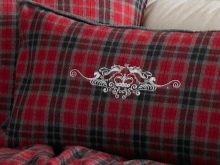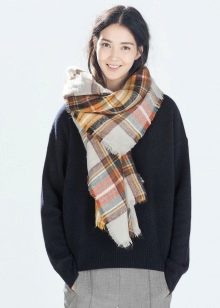What is a tartan and how to care for fabric?

Tartan is not just a beautiful fabric, but a material with an interesting history and a number of very significant advantages. For example, thanks to the twill weaving, the fabric is characterized by increased strength.



What it is?
Today, the term tartan means any fabric in a large cage, that is, with a print characteristic of the national clothes of the inhabitants of Scotland. Previously, it was made only from 100% wool, but today the checkered color can be applied to fabrics with a different composition, for example, on cotton or mixed bases. Since the middle of the 20th century, the production of wool blend plaids from viscose, polyester and acrylic has been widespread. The plaid ornament is based on the intersection of horizontal and vertical stripes or rectangles. The resulting checkered pattern runs along a diagonal line, due to the fact that the threads are intertwined first in a straight line and then in a reverse sequence.
The second name of the fabric often sounds like "tartan" - translated from Gaelic "crosswise". However, this term is still correct to apply only to tartan fabric made of strong wool, which is used to create kilts - Scottish skirts.


The classic plaid is made from tinted yarns that are connected using the twill weave method in a well-thought-out manner. First, wool fibers are dipped in artificial dyes until they acquire the desired shade. Then they are fed into the device, and a certain sequence is formed.The looms are set so that the weft and warp fibers are joined asymmetrically, for example, the weft overlaps 5 warp threads. Due to this, a textured scar appears on the front side of the product. In the case when synthetic fabric, linen or silk is used as a base, the patterns are applied over it.
The original plaid not only looks impressive, but also extremely pleasant to use. Its canvas is dense, and therefore does not tear or deform. The fabric is stain resistant, hygroscopic and exhibits good thermal insulation. However, the checkered fabric has to be looked after with special care, at least protected from moths and processed from pellets. A low-quality plaid fades after the first wash, and stretches with improper care.
It should also be mentioned that 100% wool can cause discomfort to some people.


Origin story
The history of the Scottish woman, as the name suggests, dates back to Scotland. It was in this country that the fabric with a checkered pattern appeared in the 4th century. By the way, before that, a kind of tartan for kilts was made from sheep's wool of light and dark colors. Initially, the tartan was used exclusively for men's kilts: the overall canvas was twisted at the waist, and its free end was thrown over the shoulder. Since the 18th century, the tartan was also used for sewing small kilts, the tradition of wearing which, surprisingly, appeared among lumberjacks. In the 19th century, the material began to be actively used in industry: hunting suits, hats, blankets and other home textiles were created from it.
Interesting that earlier, the pattern on plaid kilts was made unique for each genus. Looking at the print, one could draw a conclusion about the ancestors of a person, his place of birth and belonging to a clan. In the future, cities and universities acquired individual colors of the plaid. For a while, this memorable fabric even managed to be forbidden. From the middle of the 18th to the 19th century, a royal decree was in force limiting the production of the material due to its association with the Jacobin revolt.
The ban ceased to operate after the meeting of George IV and Walter Scott in 1822, but the Scottish woman remained a symbol of freedom and romanticism.


Basic properties
If we consider the classic woolen tartan, then its characteristics include significant density and smoothness, as well as low crumbling and the same low crease. The material is not elastic, but it can be used for a long time without losing its original appearance. However, it should still be mentioned that the tartan is quite clearly electrified and poorly breathable. The hygroscopicity of the material does not go beyond 6-12%. Soft fabric conducts heat well, and it warms up very well when made from cotton or wool.
The addition of synthetic threads to the composition makes the fabric more elastic and wear-resistant, and because of the cotton fibers, the material begins to wrinkle and shrink more during washing.


Views
Plaid canvases can be classified in two ways.
By appointment
Tartan varieties designed for different needs usually differ in density and a number of other characteristics. It is customary to allocate paid materials that are used for shirts and blouses, dresses and skirts. As a rule, they are made on the basis of cotton or a mixture of it with a small amount of synthetics. This variety can also be called a shirt and can be extended to indoor clothing such as dressing gowns and pajamas. Suit the variety is made of wool or semi-wool. As the name suggests, it is designed for sewing suits, trousers and jackets.


Suitable for creating a coat coat plaid - made on the basis of wool with synthetic additives. The furniture variety is used for upholstery and covers.
In addition, a polyester-based synthetic fabric is separately distinguished, from which school uniforms, some outerwear and home textiles are sewn.


By ornaments
In the closed registry of the Scottish Tartans World Register, there are more than 3.5 thousand variations of Scottish cage ornaments, including images related to royal families, aristocratic families and the oldest schools. There are even more of them in the open list of the Scottish Register of Tartans - about 7 thousand. A rather popular variety is "Royal Stewart" - a red-colored fabric, the cells of which form stripes of white, blue and yellow. Black Watch is easily identified by the presence of squares composed of green, blue and gray stripes. The Glenchek variation is characterized by the presence of black and white rectangles and squares, showing a graphic pattern.


The famous "Burberry", aka "Nova" - these are stripes of white, red and black on a beige base. The Caledonia tartan is known for its blue-black-green checkered pattern on a reddish canvas. The Black Guard has an interesting history - black fabric with pale stripes of blue, green and gray. It was she who was nevertheless allowed to be shown to the royal troops in those days when the Scotswoman was in disgrace. Quite common is the "Goose foot", the surface of which is covered with cells with diagonally elongated corners.


Colors
As mentioned above, the tartan color options are not limited to anything.
Moreover, every year more and more unique designs are added to the Scottish Register of Tartans, combining seemingly incompatible shades.

Applications
If initially tartan was used only for sewing kilts, today you can create any item with a characteristic cage, right down to underwear. A dense tartan based on woolen fibers, ideal for creating outerwear: coats, short coats and jackets. A business wardrobe allows you to "play" with a cage in suits and vests.
I must say that for classic male looks in this case, the most often used ornaments "Prince of Wales", "Burberry" and "Black Duck". Caledonia and Royal Stewart ornaments are more suitable for informal trousers and jackets.


Plaid shirts, both for men and women, are made from semi-wool, fine cotton and flannel. In women's wardrobe, tartan is increasingly found in the form of dresses and playful short skirts. The checkered material is also used to create school uniforms and home clothes, shawls and scarves, ties, bags and baseball caps. In interiors, tartan is present in the form of curtains and blankets, upholstery of upholstered furniture and tablecloths.



Care Tips
A classic plaid without synthetic impurities requires special care. Before washing, the product must be turned inside out. Cleaning should ideally be done separately from other fabrics using liquid detergents. It is better to wash by hand, or by choosing the "Wool" mode among the programs that the washing machine has. In both cases, the temperature should not exceed 30 degrees. This is true for both woolen and semi-woolen things.
Cotton products, as well as those sewn from mixed or synthetic materials, are washed at a temperature not exceeding 40 degrees, in the delicate wash cycle.

Natural woolen garments are wrung out with great care and only by hand. If the processing of other variations of the plaid is carried out in the machine, then the mode should be activated up to 800 rpm. The thing is to be dried on a flat horizontal surface, protected from direct sunlight and located away from heating appliances. By the way, the plaid must not be soaked or sent to the wash using bleaches.
The material should be ironed at an average temperature of 130 to 150 degrees from the wrong side. The rolls of tartan items are cut with a special device or an old toothbrush moved along the fibers. If you find clues, you will need to pull the protruding fiber to the wrong side and fix it with small stitches. Uncomplicated spots can be eliminated by rubbing the woolen thing with a dry brush with soft bristles.

Such things are stored in a regularly ventilated space that provides protection from light and moisture. It will be correct to pre-distribute the products on the covers and provide a moth repellent.








